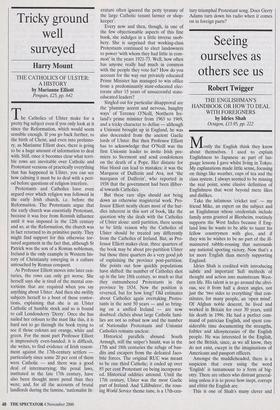Tricky ground well surveyed
Harry Mount
THE CATHOLICS OF ULSTER: A HISTORY by Marianne Elliott Penguin, £25, pp. 642 The Catholics of Ulster make for a pretty big subject even if you only look at it since the Reformation, which would seem sensible enough. If you go back further, to the birth of Christ, and even into prehisto- ry, as Marianne Elliott does, there is going to he a huge amount of information to deal with. Still, once it becomes clear what terri- ble rows are inevitable over Catholic and Protestant versions of practically everything that has happened in Ulster, you can see how calming it must be to deal with a peri- od before questions of religion interfere.
Protestants and Catholics have even argued over which religion was followed in the early Irish church, i.e. before the Reformation. The Protestants argue that the early church was essentially Protestant, because it was free from Romish influence until it was imposed in the 12th century and so, at the Reformation, the church was in fact returned to its primitive purity. They might find support for this otherwise tor- tured argument in the fact that, although St Patrick was the son of a Roman nobleman, Ireland is the only example in Western his- tory of Christianity emerging in a culture untouched by Roman conquest.
As Professor Elliott moves into later cen- turies, the rows can only get worse. She herself says she is tired of the mental con- tortions that are required when you say anything about Ulster. And then she swiftly subjects herself to a bout of these contor- tions, explaining that she is an Ulster Catholic of humble stock and so is bound to call Londonderry 'Deny'. Once she has nailed her colours to the mast like this, it is hard not to go through the book trying to see if those colours are orange, white and green. For the most part Professor Elliott is impressively even-handed: it is difficult, she writes, to find evidence of Irish resent- ment against the 17th-century settlers particularly since some 20 per cent of them were Catholic — and there was a good deal of intermarrying; the penal laws, instituted in the late 17th century, have also been thought more penal than they were; and, for all the accounts of brutal landlords during the famine, 'nationalist lit- erature often ignored the petty tyranny of the large Catholic tenant farmer or shop- keeper'.
Every now and then, though, in one of the few objectionable aspects of this fine book, she indulges in a little inverse snob- bery. She is surprised that working-class Protestants continued to elect landowners to power 'with whom they had little in com- mon' in the years 1921-73. Well, how often has anyone really had much in common with the people they vote for? How do you account for the way our privately educated Prime Minister has managed to win office from a predominantly state-educated elec- torate after 15 years of unsuccessful state- educated leaders?
Singled out for particular disapproval are the 'plummy accent and nervous, haughty ways' of Terence O'Neill, Northern Ire- land's prime minister from 1963 to 1969, and a tricky character to define — although a Unionist brought up in England, he was also descended from the ancient Gaelic lords of Ulster. But then Professor Elliott has to acknowledge that O'Neill was the first Unionist leader to invite Irish pre- miers to Stormont and send condolences on the death of a Pope. Her distaste for blue blood can lead to mistakes: it was the Marquess of Dufferin and Ava, not 'the marquess of Dufferin', who reported in 1938 that the government had been illiber- al towards Catholics.
But these rare slips should not bring down an otherwise magisterial work. Pro- fessor Elliott neatly clears most of the hur- dles inherent in this sort of book, like the question why she deals with the Catholics of Ulster alone: until partition, there seems to be little reason why the Catholics of Ulster should be treated any differently from the Catholics of Ireland. But, as Pro- fessor Elliott makes clear, three quarters of the hook may be about pre-partition Ulster but those three quarters do a very good job of explaining the province post-partition. She points out how quickly populations have shifted: the number of Catholics shot up in the late 18th century, so much so that they outnumbered Protestants in the province by 1834. Now the position is reversed, but for how long? Old estimates about Catholics again overtaking Protes- tants in the next 50 years — and so bring- ing on a unified Ireland — are now doubted: clichés about large Catholic fami- lies are not so robust now and the number of Nationalist Protestants and Unionist Catholics remains unclear.
Historical parallels abound. South Armagh, still the sniper's haunt, was in the 17th and 18th centuries the refuge of ban- dits and escapers from the defeated Jaco- bite forces. The original RUC was meant to be one third Catholic; it ended up over 85 per cent Protestant on being incorporat- ed. Historical oddities astound. Until the 17th century, Ulster was the most Gaelic part of Ireland. And Tillibulero', the rous- ing World Service theme tune, is a 17th-cen- tury triumphal Protestant song. Does Gerry Adams turn down his radio when it comes on in foreign parts?


























































































 Previous page
Previous page